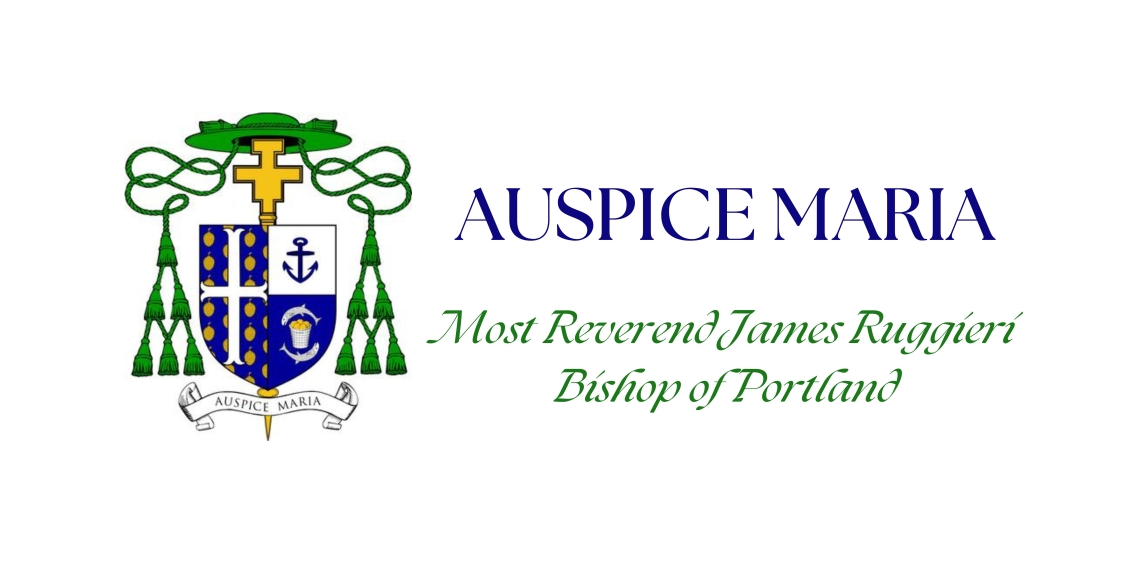Auspice Maria: A Message from Bishop Ruggieri

A part of my new experience as a bishop was attending a new bishops’ orientation in Rome for a week in September. The Dicastery for Bishops organizes the orientation. There were almost 300 new bishops in attendance. We heard from different cardinals, bishops, priests, and laity who work in the Roman Curia, the various offices that help the pope govern the Church. One of the highlights of the experience was an audience with Pope Francis.
The audience with Pope Francis took place on Thursday of the week. First, we celebrated Mass at what is known as the Altar of the Chair. It is the altar in front of the majestic bronze sculpture of the Chair of Peter in St. Peter’s Basilica. The Chair of St. Peter in St. Peter’s Basilica contains a relic of a wooden throne that apostolic legend reports was used by St. Peter himself. The Chair or “cathedra” represents the pope’s universal teaching authority in the Church and the unity of the Church under his leadership. The artistic beauty of the Chair of Peter is a masterpiece. Unfortunately, during our time at the basilica, the chair was wrapped in staging because of recent restoration being done in preparation for the Jubilee of 2025. After Mass, we had our audience with Pope Francis.
Every diocesan bishop has a “cathedra” in the cathedral. Only the diocesan bishop sits on it because it symbolizes his authority as the first teacher in the diocese he shepherds. In the Cathedral of the Immaculate Conception in Portland, the cathedra is in the sanctuary behind the altar. Above the chair is the bishop’s coat of arms. On the day of my ordination and installation, Cardinal O’Malley, the primary ordaining bishop, led me to the chair and had me sit on it. At that moment, sitting on the chair for the first time after ordination, I was “installed” as the 13th bishop of Portland. It was a very moving and significant moment because it was the beginning of my episcopal ministry in Maine.
As a bishop of a particular Church or diocese, I experienced the unity of the universal Catholic Church that day I met the Holy Father. He is our chief shepherd. He is our “Peter,” who has been given the authority to govern and shepherd the universal Church. Another time during the orientation I experienced the universality of the Church was when our group of bishops united with another group of new bishops who were lodged at a different location in Rome. These bishops were from various missionary dioceses throughout the world. One of the bishops I met when we had joint lectures was from Sri Lanka and his diocese is under the care of the Pontifical Missionary Societies. There are four Pontifical Missionary Societies: the Society of the Propagation of the Faith, the Society of the Holy Childhood, the Society of St. Peter the Apostle, and the Society of the Missionary Union. Each has a unique role in promoting and living the missionary call of Jesus for his Church. The second collection taken up on the penultimate Sunday in October for World Mission Sunday is managed by the Society of the Propagation of the Faith.
The following describes the intriguing beginning of the Society of the Propagation of the Faith and is taken from the Pontifical Missionary Societies’ website.
“In 19th century France, the Church emerged from the severe persecution of the French Revolution. During the Napoleonic period (1804-1815), the Missions Etrangères de Paris (MEP) – Foreign Missions of Paris – managed to send only two missionaries to the Far East. It was in these circumstances that the charisma of the Spirit was placed on a young woman from Lyons, Pauline Marie Jaricot, who, after a comfortable life, [then] rediscovers the authenticity of faith in Christ and dedicates herself wholeheartedly to this charisma. She established a union of prayer among pious servant girls, the members of which were known as the ‘Réparatrices.’”
Pauline along with nine others committed themselves to find 10 other people who would “pray weekly and donate a penny for the Missions.” Pauline’s initiative inspired many and the effort multiplied rapidly. Thus, it “led to the official founding of the ‘Association of the Propagation of the Faith’ on May 3, 1822.” On May 3, 1922, Pope Pius XI gave his pontifical approval and declared the association the Society of the Propagation of the Faith.
It is amazing how the Holy Spirit worked within the hearts of Pauline Jaricot and her nine companions. Today, the Society for the Propagation of the Faith invests money in numerous projects and ministries in developing countries to help pass on the Catholic Christian Faith.
In conclusion, we all have a part in the missionary work of the Church. Some are missionaries in foreign lands, and some are missionaries in the familiar surroundings of their families, parishes, and dioceses. Pope Francis writes in his 2024 World Mission Sunday address: “The Church, for her part, in fidelity to the mission she has received from the Lord, will continue to go to the ends of the earth, to set out over and over again, without ever growing weary or losing heart in the face of difficulties and obstacles.” We are all called to be ‘missionary disciples.’ Please pray for all missionaries. Please pray for each other, that we all may be credible witnesses to the Gospel. Also, if you are able, prayerfully consider a sacrificial offering to the second collection in your parishes this coming weekend. Thank you. God bless you.
-Most Reverend James Ruggieri, Bishop of Portland









